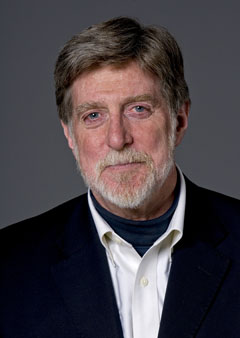Thought Leader Profile
John Delaney
John R. Delaney Professor of Oceanography, University of Washington; Director and Principal Investigator, Regional Scale Nodes, NSF Ocean Observatories Initiative; and Jerome M. Paros Endowed Chair in Sensor Networks
John R. Delaney is a professor emeritus of Oceanography and held the Jerome M. Paros Endowed Chair in Sensor Networks at the University of Washington for ten years. Beginning in 1997, he directed the evolution and development of the first US Regional Cabled Ocean Observatory, which was initially known as NEPTUNE and is now the Regional Scale Nodes program within the National Science Foundation's Ocean Observatories Initiative. The construction phase of this OOI cabled component began in September 2009 with the announcement of an award to the University of Washington of $126 million over five-and-a-half years.
John led the UW team of scientists and engineers who designed, built, and are now operating the regional cabled observatory. Spatially coincident with the Juan de Fuca tectonic plate in the northeast Pacific Ocean, this 575-mile cabled network offers a revolutionary approach to studying, interacting with, and understanding Earth's "inner space" by providing power and two-way, high-bandwidth communications between humans on land and instrument-robot systems offshore on the seafloor and up through nearly two miles of the overlying water column. This distributed remote sensing network has converted the Juan de Fuca tectonic plate and the dynamic overlying ocean into an internationally accessible, interactive, real-time natural laboratory capable of reaching millions of users via the Internet. Such networks are emerging as a major element in next-generation Ocean and Earth science research and education.
John's career was launched as a mining geologist in Virginia, Maine, and Arizona in the late 1960s. Fieldwork on the volcanically active Galapagos Islands in the early 1970s hooked him on all things volcanic. Early exploration of the Juan de Fuca Ridge using the ALVIN research submersible led him to the then-nascent world of submarine volcano-hydrothermal research. It soon became clear that understanding the mid-ocean ridge (MOR) system, where more than 60% of the Earth's vulcanism occurs, required a cross-disciplinary approach, so with support from the National Academy of Sciences, John began to organize a group in 1985 that became known as the RIDGE Program. He served as the first chair of RIDGE in 1988 and continued on the steering committee until 1992.
In 1987, John founded and led InterRIDGE, an international organization of more than 20 nations focused on MOR research. Both programs were designed to foster intensive studies of the physical, chemical, and biological interactions that characterize the vigorous volcanic and hydrothermal activity along the 70,000-kilometer MOR system. RIDGE and InterRIDGE, which is still active today, have channeled hundreds of millions of dollars into research and education focused on the complex interactions that support exotic life forms in hydrothermal systems below the seafloor. John also served on several NASA committees charged with defining the nature of missions to Europa, one of the moons of Jupiter, suspected of harboring both a liquid ocean and submarine volcanoes.
John joined the University of Washington faculty in 1977. He has published nearly 100 scientific papers and articles and served as chief scientist on more than 45 oceanographic research cruises. In the summer of 1998, he led a joint expedition with the American Museum of Natural History to successfully recover four volcanic sulfide structures now on display in AMNH's Hall of the Planet Earth. This US/Canadian effort was the subject of a NOVA/PBS and BBC documentary, Volcanoes of the Deep. Samples collected on this expedition produced the highest-temperature microbes ever cultured. Some hypotheses link these deep-sea volcanic systems to the origins of life on Earth.
In September 2005, John co-led the VISIONS '05 research expedition, which successfully broadcast the first-ever live, high-definition video from the seafloor across Europe, the Americas, and Asia. Scientists, educators, and the general public viewed the real-time video from the underwater volcanoes of the Northeast Pacific over cable and satellite television and on the web via the ResearchChannel. It was during the VISIONS '05 expedition that John was inspired to write Oceanography as Theater in the Round. The VISIONS '05 website also offers a poetry page, a unique feature focused on poetry of the sea.
Based on the successes and reception of the VISIONS '05 broadcasts, the UW team has gone on to host live broadcasts from sea during other expeditions: Enlighten '10, VISIONS '11, VISIONS '13, and VISIONS '14, which chronicles the completion of the construction phase of the OOI Cabled Array.
The most current success of the Cabled Array involves capturing the entirety of the April 2015 eruption of Axial Seamount on the Juan de Fuca Ridge (novae.ocean.washington.edu) and a unique live-streaming video from an active submarine hydrothermal system every three hours for 12 minutes all day long, at http://novae.ocean.washington.edu/story/Ashes_CAMHD_Live. The shows are at 2pm, 5pm, 8pm, and 11pm around the clock in both East Coast and West Coast times.
Speaker at FiRe 2011, 2016, 2022
|
Share this: |
News for John Delaney
-
Posted on Sat Jan 16, 2016, 8:00 am
New fiber-optic array, HD web cam helps UW scientists capture underwater erup... -
Posted on Thu Apr 30, 2015, 7:00 am
Seafloor sensors record possible eruption of underwater volcano - UW Homepage
FiRe 2022 Media
'Solve for Ocean: Technologies Addressing Challenges to the Health of Marine Ecosystems'
To contact John Delaney, fill out the form below.


